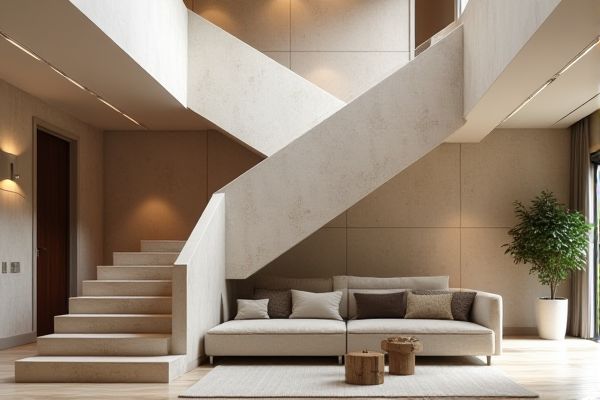
Geometric staircases emphasize aesthetic appeal with precise shapes and symmetrical designs, while ergonomic staircases prioritize user comfort, safety, and natural movement patterns to reduce strain. Discover how choosing between a geometric or ergonomic staircase can impact your space and daily experience by reading the rest of the article.
Table of Comparison
| Feature | Geometric Staircase | Ergonomic Staircase |
|---|---|---|
| Design | Symmetrical, spiral or circular patterns | Comfort-focused, with smooth transitions and optimal step dimensions |
| Space Efficiency | Maximizes vertical space, ideal for compact areas | Requires more space for gradual incline and consistent step height |
| Safety | Can be risky due to narrow steps and sharp turns | Enhanced safety with even steps and handrail ergonomics |
| User Comfort | Less comfortable, requires careful navigation | Optimized for ease of use and minimal strain |
| Construction Complexity | High, due to intricate curves and precise geometry | Moderate, focuses on step dimensions and ergonomic standards |
| Typical Use | Modern designs, decorative purposes | Residential, commercial spaces prioritizing user comfort |
Introduction to Geometric vs Ergonomic Staircases
Geometric staircases feature precise, mathematical designs emphasizing symmetry, angles, and shapes to create visually striking structures, often used in modern architecture for their aesthetic appeal. Ergonomic staircases prioritize user comfort, safety, and accessibility, incorporating optimal step height, tread depth, and handrail placement to reduce fatigue and prevent accidents. The choice between geometric and ergonomic staircases balances architectural style with practical functionality, influencing building codes and user experience.
Key Design Principles of Geometric Staircases
Geometric staircases prioritize symmetry, clean lines, and precise angles to create visually striking architectural features that enhance spatial flow and aesthetic appeal. These staircases often utilize materials like glass, steel, or polished wood to emphasize their structural rhythm and geometric patterns. Emphasizing proportionality and balance, geometric designs integrate seamlessly into modern interiors by optimizing both form and function.
Essential Features of Ergonomic Staircases
Ergonomic staircases prioritize user comfort and safety with features such as consistent step height, proper tread depth, and supportive handrails designed to reduce strain and prevent accidents. Unlike geometric staircases, which focus on precise shapes and angles for aesthetic appeal, ergonomic designs incorporate human factors to enhance usability and minimize fatigue. Your experience on an ergonomic staircase is improved through attention to natural body movement and optimal stair dimensions.
Aesthetic Appeal: Visual Impact Comparison
Geometric staircases command attention through their precise angles and symmetrical forms, creating a striking visual centerpiece in modern architecture. Ergonomic staircases prioritize human comfort with smooth curves and natural flow, producing a softer, more inviting aesthetic. The choice between the bold, structured appearance of geometric designs and the organic, approachable look of ergonomic stairs significantly influences the overall ambiance and style of an interior space.
User Comfort and Accessibility
Geometric staircases, characterized by their precise angles and consistent rise, offer predictable step dimensions that enhance user comfort by reducing trip hazards. Ergonomic staircases prioritize human movement patterns, incorporating features like varied tread depths and handrails positioned for natural grip, significantly improving accessibility for users with mobility challenges. Studies show ergonomic designs reduce fatigue and increase safety, making them ideal for environments prioritizing inclusivity and ease of use.
Space Utilization and Layout Considerations
Geometric staircases optimize space utilization by allowing for flexible layout designs, often fitting seamlessly into corners or irregular spaces, which maximizes floor area efficiency in compact environments. Ergonomic staircases prioritize user comfort and safety, influencing layout considerations by requiring consistent step dimensions and adequate landing areas, potentially consuming more floor space. Selecting between these staircases depends on balancing spatial efficiency with accessibility and usability requirements in architectural plans.
Safety Standards and Compliance
Geometric staircases must adhere to strict building codes, including specific rise and run dimensions, to ensure safe and consistent steps, reducing the risk of falls. Ergonomic staircases prioritize human comfort by integrating features like proper handrail heights, non-slip surfaces, and optimal step depth, often exceeding minimum safety standards. Your safety depends on selecting stairs that comply with local regulations while promoting ease of use through ergonomic design principles.
Material Choices and Construction Techniques
Geometric staircases often utilize materials like steel, glass, and concrete to achieve sharp lines and modern aesthetics, requiring precision welding and modular construction techniques. Ergonomic staircases prioritize comfort and safety, commonly using wood or composite materials with handrails and customized tread shapes to support natural foot placement and reduce strain. Your choice depends on whether you prefer striking design elements or enhanced usability tailored to daily movement.
Maintenance and Longevity
Geometric staircases, often made from metal or concrete, generally require minimal maintenance due to their durable materials and resistance to wear, ensuring long-lasting structural integrity. Ergonomic staircases, designed with user comfort and safety in mind, may incorporate wood or composite materials that demand regular upkeep such as sealing, polishing, or inspecting for wear to maintain optimal functionality. Choosing materials with proven resilience and planning routine maintenance significantly extends the lifespan of both geometric and ergonomic staircases.
Choosing the Right Staircase for Your Space
Geometric staircases offer sleek, modern designs ideal for maximizing space with clean lines and efficient layouts, perfect for contemporary interiors. Ergonomic staircases prioritize comfort and safety, featuring wider treads, gentle rises, and handrails that support your natural movement to reduce fatigue during use. Choosing the right staircase depends on your space's architectural style and functional needs, ensuring your staircase complements both aesthetics and daily comfort.
 homyna.com
homyna.com